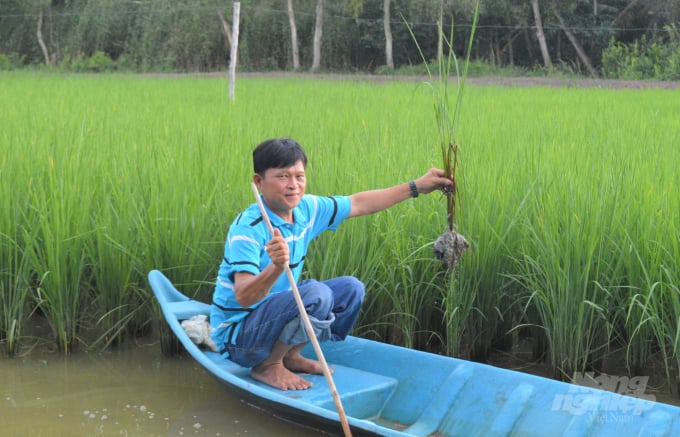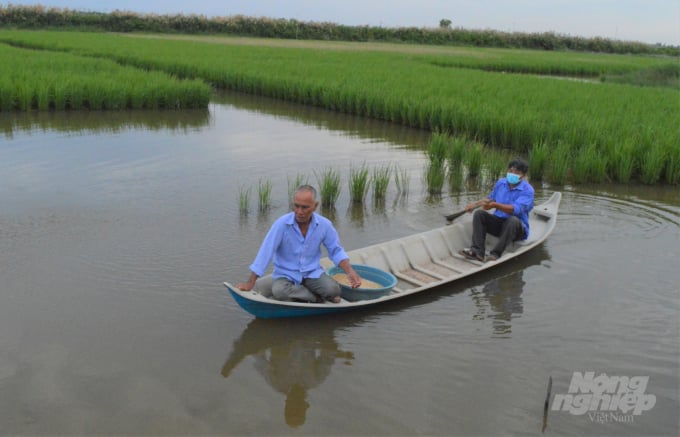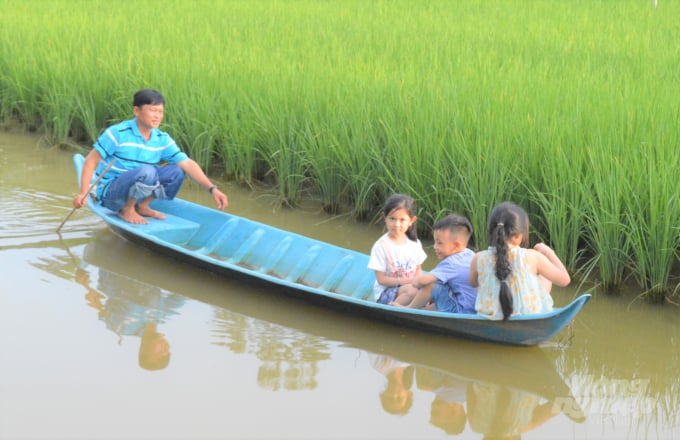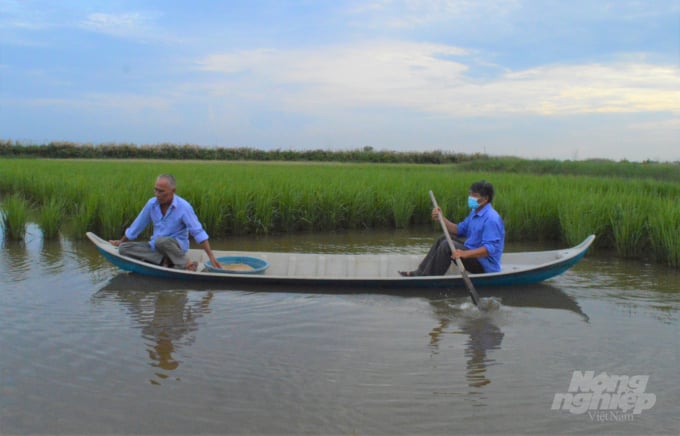May 31, 2025 | 19:11 GMT +7
May 31, 2025 | 19:11 GMT +7
Hotline: 0913.378.918
May 31, 2025 | 19:11 GMT +7
Hotline: 0913.378.918

Kien Giang is a coastal province that possesses strength points to rotate production between one rice crop and one shrimp crop - a favorable environment for organic production. Photo: Trung Chanh.
Kien Giang is a coastal province that possesses strength points to rotate production between one rice crop and one shrimp crop (rice - shrimp model). The model is mainly concentrated in the districts of U Minh Thuong including An Bien, An Minh, U. Minh Thuong and Vinh Thuan.
According to rice-shrimp farmers, the rice crop has a very low cost as it can make full use of the organic nutrients left after the shrimp crop without having to apply a lot of chemical fertilizers. Therefore even though the rice yield is only 4 - 5 tons/ha, farmers still make a profit not lower than other intensive-farming, high-yield places.
Ba Khuyen the “Elder Farmer” (Mr. Nguyen Van Khuyen, Dong Hung B commune, An Minh district, Kien Giang) said, "In the past farmers here only grew rice crops and caught natural freshwater fish. Their earnings were not only low but also very precarious. The movement of switching to rice-shrimp farming about 20 years ago had clearly brought much higher income for them."

The shrimp surrounding the rice root will create an organic-nutrient environment to help the plant grow without the need for additional chemical fertilizers and achieve great results. Photo: Trung Chanh.
Mr. Pham Thanh Dan, a member of Nam Quy Agricultural Cooperative (Nam Thai commune, An Bien district, Kien Giang) has also switched to the rice-shrimp model for nearly ten years. Particularly for the last three years he has cooperated with businesses to produce organic rice according to international standards, gaining high incomes.
“Farmers feel very secure after following the linkage model. It’s because the enterprise has given support in terms of investment costs from rice seeds, organic fertilizers, biological pesticides to production procedures, which will only be deducted at the latter half of the rice crop. I choose to plant ST25 fragrant rice. The products will be underwritten at a fixed price of VND 9,000/kg. Our incomes increase, and our lives are now stable," said Mr. Dan excitedly.
According to Mr. Pham Chi Thuong, director of Nam Quy Agricultural Cooperative, the co-op members have been cultivating international organic-qualified rice for the past three years. Currently two enterprises are jointly signing joint production contracts with cooperatives and producing organic rice.
The underwrite price of rice is relatively high (purple ST rice VND 10,000/kg, VND ST25 9,000/kg). This has led to an average profit up to VND 40 - 42 million/ha.
The profit from shrimp reaches VND 70 - 90 million/ha, not to mention the additional income from crabs from intercropping. The production environment here has been certified as “organic” so farmed shrimp and crabs are also very secure.
The favorable production environment has attracted many businesses to come look for rice-shrimp areas for investment. The goal is to create production linkages and a sustainable material area.
For many years, Bo De Fishery Group has coordinated with mass organizations and local authorities with projects to professionalize farmers and introduce biotechnology into rice - shrimp production which brings many positive effects.
The “Bo De - Mother Water” biological product has helped many shrimp smallholders successfully treat the cultivation water, increase productivity and quality, thus improving income. The shrimp farming environment has zero residues of toxic chemicals which promote the development of microorganisms, improve the soil, and effectively produce clean organic rice.

The organic rice-shrimp model has low investment cost thanks to utilizing nutrients from shrimp farming resulting in high profits. Photo: Trung Chanh.
According to Mr. Nguyen Anh Tuan, Director of Green Stars Investment JSC, the company wishes to cooperate with cooperatives to farm ST24 and ST25 rice varieties on shrimp land following the biological organic process for exportation to the US market.
The condition is that participating cooperatives must have a large enough farming area of 50-100 ha, convenient transportation routes (at least 50-ton boats can enter). When the link has been created they must comply with the terms of the business regarding requirements of the cultivation area’s planning for products exporting to the EU and US markets.
On the company’s part, Green Stars will provide seeds and all agro-inputs materials for cooperatives. The business also plans to apply scientific and technical advances in farming. The “FaceFarm” management software is a prime example. The application provides a production log, management of agro-inputs, cost and traceability - provision of QR Code of planting area).
Cooperatives will receive training to be able to apply the farming process and use “FaceFarm”. Hiep Ngoc JSC (Can Tho City) will accompany Green Stars Investment JSC to sign an underwriting contract with cooperatives to purchase bio-organic rice as well as rice produced on shrimp land (ST24, ST25).

The favorable production environment has attracted many businesses to come look for rice-shrimp areas for investment. Photo: Trung Chanh.
In a recent meeting with the People's Committee of Kien Giang province regarding the pilot project to build a large material area for rice production in the Mekong Delta, Deputy Minister of Agriculture and Rural Development Tran Thanh Nam directed the construction of the inter-provincial organic rice-shrimp production area.
An Minh (Kien Giang) and Thoi Binh (Ca Mau) will be the first to be selected. The total pilot area will be several thousand hectares accompanied by the participation of businesses in the seafood and rice chain. Moreover international organizations will be invited to join the consultation for technical transfer and granting certifications of global value.
Accordingly, an organic rice-shrimp production chain will be formed, from developing raw material areas to purchasing, processing and exporting, which will improve product value.
Translated by Samuel Pham

(VAN) Several scientists and farmers are experimenting with soil treatment in some key durian-growing regions such as Cai Lay (Tien Giang), Dak Song, Gia Nghia, and Dak R’lap (Dak Nong).
/2025/05/25/4127-3-073637_820.jpg)
(VAN) Thanks to the promotion from an FAO-implemented project, vegetable production in greenhouses in Moc Chau has seen strong development, from 1.5 hectares in 2021 to nearly 50 hectares in 2024.

(VAN) FAO has recently supported USD 140,000 to implement the project 'Risk mitigation human-animal interface risks through disease control initiatives in pig farming.'

(VAN) The People's Committee of Tra Vinh province has approved an adjustment to the investment policy for the Green Hydrogen Plant project, increasing its area to approximately 52.76 hectares.
![Reducing emissions from rice fields: [2] Farmers’ commitment to the soil](https://t.ex-cdn.com/nongnghiepmoitruong.vn/608w/files/news/2025/05/05/dsc08881jpg-nongnghiep-140632.jpg)
(VAN) Clean rice cultivation model in Thuong Tan commune, Bac Tan Uyen district, is assisting local residents in achieving sustainable agriculture by substantially reducing costs, increasing productivity, and protecting the environment.

(VAN) At the conference to disseminate Resolution No. 68, AgriS introduced its digital agricultural ecosystem and reaffirmed its commitment to accompanying the Government in promoting private sector development and sustainable agriculture.

(VAN) 'Blue Ocean - Blue Foods' initiative is designed to restore marine ecosystems and establish sustainable livelihoods for local communities by cultivating a minimum of 1,000 hectares of cottonii seaweed in the first three years.